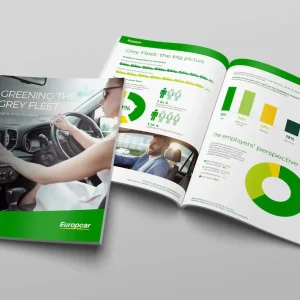Fleet management has consistently been a driving passion for John Fraser, who stepped into the position of GoFibre’s fleet manager a little over a year ago.
With a remarkable tenure of 36 years in the fleet industry, Fraser’s career path has been marked by notable roles such as a fleet controller at Ford Motor Company, a fleet manager at the Bank of Scotland, and his most recent position as the fleet manager for Standard Life. In the latter role, he held the responsibility for overseeing fleets across the UK, Germany and Austria.
While his tenure at GoFibre is relatively short, Fraser’s enthusiasm for the task is palpable as he seizes the opportunity to enact transformative changes within the company’s fleet operations.
GoFibre is the trading name for Borderlink Broadband, a Scottish independent broadband builder and provider founded in Duns in the Scottish Borders in 2017.
With rural areas like Duns being largely underserved when it comes to digital connectivity, GoFibre was born out of the need to solve this issue.
“It’s our mission to ensure that rural and harder-to-reach communities are not left behind,” Fraser tells us. Over a short span, GoFibre has positioned itself as a leading broadband provider, particularly in remote areas. “We have quickly established ourselves as the next big broadband provider, particularly for rural and underserved areas and communities.”. Leveraging a distinctive wireless technology comprising 100-plus relay systems across an expansive 3,500km² and expanding further, the company strives to address the digital divide.
The current fleet encompasses 120 vehicles, and this number is poised to double in the coming year as GoFibre dedicates itself to its mission of inclusivity for remote communities. Fraser currently manages the fleet single-handedly, though he aspires for assistance in the future.
While it has become common for various departments like HR or procurement to assume fleet management responsibilities, Fraser emphasises the importance of having a dedicated fleet manager in-house. He notes that managing fleets solely through spreadsheets relies on individual accuracy, which can lead to errors.
“Fleet management often fits into compensation benefits or HR but managing the fleet on spreadsheets is only as good as the person putting the date in them,” notes Fraser.
GoFibre’s fleet predominantly consists of commercial vehicles, comprising 106 vans from diverse manufacturers and approximately 20 Suzuki Swifts utilised by the field-based sales team, which includes several cash-allowance drivers. Fraser anticipates inevitable trends such as fleet expansion and a surge in electrification, underscoring the necessity of a traditional fleet manager to navigate these developments effectively.
The first thing Fraser did when he arrived was to switch the fleet to contract hire through a single provider, Arnold Clark, on a four-year contract hire deal, with an annual mileage of approximately 20,000.
The partnership includes a bolt-on fleet maintenance package for the fleet. “In the year that I’ve been here, I’ve taken the fleet from having no fleet manager and no maintenance arrangement to having both of those things,” Fraser tells us.
“Not having a fleet maintenance package wasn’t ideal. The new agreement with Arnold Clark means instead of us going all over the place looking for service and repairs because we had multiple accounts, we will now have one provider with one consolidated monthly invoice. They also provide daily rental coverage and garage network coverage and everything we need, so it’s ideal, and takes it off my hands so I have more time for other things.”
The fleet uses Arnold Clark’s Auto Centre, an online portal in which Fraser can see
the whole fleet, including who is driving which car and the upcoming maintenance of each vehicle.
“Historically, people were driving with their brakes squealing, for example, damaging the callipers.” With the Arnold Clark portal, Fraser can more responsibility place their vehicles – noting if there’s anything wrong, as well as getting service and MOT reminders.
With sourcing new vehicles a problem for many fleets at the moment due to the ongoing semiconductor shortage, Fraser also hopes vehicle supply will be improved by choosing a major leasing company.
Improving the safety of the fleet
The introduction of telematics since Fraser’s arrival as fleet manager has also brought several benefits to the fleet, including fuel savings, reducing penalties and fines, and driving down insurance costs. The business has also been able to get a better understanding of vehicle usage patterns.
The fleet has a contract with Inseego for vehicle tracking. “Every vehicle is tracked so we know where people are and we get a breakdown of those who are harsh braking, carrying out illegal manoeuvres and idling, for example,” says Fraser.
When they first ran the weekly report, Fraser tells us “it was like a telephone directory”, but now the amount of illegal activity has slowed right down. “That shows its effectiveness as people know how they should be driving and are now more inclined to drive better while at work, improving their safety and reducing the risk of crashes on our fleet.”
This type of monitoring makes Fraser’s job easier, and he now spends far less time figuring out who has incurred a parking fine, for example. This monitoring of driver behaviour is expected to deliver savings in terms of maintenance and repairs as new vans join the fleet, Fraser says.
He adds: “We will also be looking to potentially work with RoSPA to see what additional benefits and training they can offer us as a business.”
Decarbonising the fleet
GoFibre is committed to achieving net-zero emissions by 2050. Furthermore, through its carbon reduction plan, the company is targeted to achieve net-zero emissions
by 2041.
With these goals, combined with the constant improvement of electric vehicle technology, Fraser says it is economically and sustainably advantageous to migrate the fleet to complete electric vehicle use.
For now, however, the GoFibre fleet is currently 95% diesel. Fraser says the reason for this is due to the rural nature of where the fleet operates, which has proved challenging for electric vehicle adoption thus far.
“We’re only at the very start of this journey,” explains Fraser, who notes that a recent electric van trial proved unsuccessful. “We trialled electric vans, and we will have to adopt them soon enough, but the problem is that because we work so rurally, the range just doesn’t cut it for us yet.
“If you look at the range the manufacturers tell you, we discovered we can half that. If you put the heating on when it’s cold outside – these factors are affecting the range all the time,” notes Fraser.
“We had a demonstration of electric vans, but the range was terrible – 120 miles – and we do a lot more miles than that,” he says. “We are looking at other things, and hydrogen is one of them. Unless electric vans can offer us 350 miles, which I have no doubt they will one day, we cannot adopt them onto our fleet.”
Fraser is investigating alternatives, including hybrid and hydrogen.
“We have secured a rolling electric vehicle demonstration programme with Renault in which we intend to issue to selected drivers to basically give them an understanding and in-depth knowledge of how living with an electric van would work for the business,” says Fraser.
The technical team employs these vehicles for installations, while the health and safety personnel, delivery managers and sales team operate hybrid Suzuki Swifts. The current fleet comprises approximately 20 cars. Fraser continues: “We are in the process of introducing company vehicles for specific roles that necessitate them. As we implement these changes, we anticipate a gradual increase in the number of cars within
our fleet.”
Currently, the fleet primarily consists of petrol hybrids and PHEVs, with a deliberate avoidance of diesel vehicles as part of the policy. “The demand from our staff often centres around 4×4s such as T-Rocs,” says Fraser.
He has noticed a shift away from premium brands as lower-end vehicles gain traction due to their enhanced feasibility and appeal due to lower taxes.
“While certain elements of brand loyalty persist, the financial advantages inherent in company car ownership remain a compelling factor,” he says.
With this in mind, Fraser expects electric cars to be attractive to fleet drivers. “Introducing electric vehicles into our offering is anticipated to be a popular choice due to associated tax incentives. Nonetheless, it’s important to acknowledge that these tax breaks may not last too long,” Fraser says.
However, further challenges emerge when considering vans. These vehicles accumulate significant mileage, and until long-range electric options become viable, an absence of suitable charging infrastructure persists.
In possibly a two to three-year time frame, Fraser anticipates a shift. “Electric vans are expected to join our fleet, although for now, diesel vans remain in use due to the current limitations of electric van ranges.
“My strategic vision involves embracing new technologies while carefully navigating the practicality and feasibility of electric vehicles for their diverse operational needs,” Fraser concludes.





